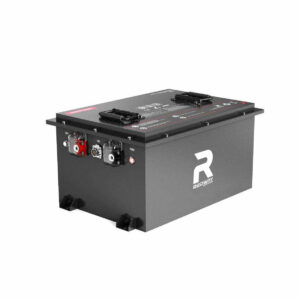What Are the Different Types of RV Batteries and Their Key Differences?
Lithium-ion batteries offer 80-100% DoD, 2,000-5,000 cycles, and 50-70% weight reduction versus lead-acid. They charge faster, perform in extreme temperatures, and require zero maintenance. Though pricier, their longevity and efficiency make them ideal for frequent travelers or off-grid setups. Built-in Battery Management Systems (BMS) prevent overcharging and overheating.
How to choose the best RV battery for your needs?
The shift toward lithium solutions aligns with the growing demand for sustainable RVing. Many owners report eliminating generator dependency through solar-lithium combinations, achieving full off-grid capability for weeks. Vanlife conversions particularly benefit from lithium’s compact size – a 100Ah lithium battery weighs 30lbs versus 60-70lbs for lead-acid equivalents. Manufacturers now offer modular designs allowing users to expand capacity incrementally. While the upfront cost remains higher (typically $900-$2,000 per 100Ah), the total cost of ownership often proves lower when factoring in 10-year lifespans versus 3-5 years for lead-acid. Recent advancements like self-heating lithium batteries now address cold-weather charging limitations, making them viable for four-season use.
How Does Temperature Impact RV Battery Efficiency?
Cold reduces lead-acid capacity by 30-50%, while heat accelerates corrosion. Lithium batteries operate efficiently from -4°F to 140°F but may require insulation in freezing conditions. Install batteries in temperature-controlled compartments and use heating pads or ventilation to mitigate environmental stress.

What are the key applications and considerations for RV batteries?
Temperature extremes create unique challenges for each battery chemistry. Lead-acid batteries suffer electrolyte freezing below 20°F, requiring battery warmers in winter. Conversely, at 90°F+ temperatures, flooded batteries lose water rapidly through evaporation. AGM batteries handle heat better but still lose 20% capacity above 100°F. Lithium batteries maintain stable performance across wider ranges but should never be charged below 32°F without built-in warming systems. Many RVers install thermal wraps and compartment fans – a 2023 industry survey showed 68% of lithium users added insulation in sub-freezing climates. For optimal performance, maintain batteries between 50°F-85°F using these solutions:
| Solution | Lead-Acid | Lithium |
|---|---|---|
| Winter Insulation | Required below 20°F | Optional below -4°F |
| Summer Cooling | Ventilation critical | Passive airflow sufficient |
| Charging Temp Range | 32°F-104°F | -4°F-131°F |
“Lithium batteries are revolutionizing RV power due to their lightweight design and longevity. At Redway, we’ve seen a 40% increase in customers upgrading from lead-acid to lithium, especially for solar integrations. However, proper installation and temperature management remain critical to avoid performance issues.”— Redway Power Solutions Engineer
Deep Cycle LiFePO4 Golf Cart Batteries Manufacturer, LiFePO4 Golf Cart Batteries
News
In 2025, the RV industry has seen significant advancements in battery technology, leading to the development of various battery types, each with distinct features and benefits. The primary categories include:
Lead-Acid Batteries
Traditional and cost-effective, lead-acid batteries have been a staple in RV power systems. They are heavier and have a shorter lifespan compared to newer technologies. Regular maintenance is required to ensure optimal performance.
Absorbent Glass Mat (AGM) Batteries
A subtype of lead-acid batteries, AGM batteries offer improved efficiency and are maintenance-free. They are more resistant to vibration and can handle deeper discharge cycles, making them a popular choice for RV enthusiasts seeking reliability without frequent upkeep.
Lithium-Ion Batteries
Dominating the RV market, lithium-ion batteries provide a significant weight reduction of 50-70% compared to lead-acid counterparts. They boast over 3,000 charge cycles and offer 95% charging efficiency. Their thermal stability ensures reliable performance in extreme travel conditions.
Solid-State Batteries
Emerging as the next frontier in RV power systems, solid-state batteries replace liquid electrolytes with solid conductive materials. This design offers faster charging times, enhanced safety by eliminating fire risks, and higher energy density. Manufacturers like QuantumScape are developing prototypes that promise extended travel ranges and reduced charging durations.
Sodium-Ion and Graphene-Hybrid Batteries
Utilizing abundant materials like aluminum and salt, these batteries present a sustainable alternative by avoiding rare earth metals. They are 100% recyclable and have an 80% lower CO2 footprint, aligning with eco-friendly initiatives in the RV industry.
Key Differences
-
Weight and Size: Lithium-ion and solid-state batteries are notably lighter and more compact than lead-acid variants, enhancing RV fuel efficiency and storage space.
-
Lifespan and Efficiency: Lithium-based batteries offer longer lifespans and higher efficiency rates, reducing the frequency of replacements and overall maintenance costs.
-
Safety: Solid-state batteries provide improved safety profiles by mitigating risks associated with liquid electrolytes, such as leaks or fires.
-
Environmental Impact: Sodium-ion and graphene-hybrid batteries contribute to sustainability efforts through the use of recyclable materials and reduced environmental footprints.
FAQs
- Q: Can I mix different RV battery types?
- A: No—mixing chemistries or ages causes imbalance, reducing efficiency and lifespan.
- Q: How long do lithium RV batteries last?
- A: 10+ years with 2,000-5,000 cycles, outperforming lead-acid by 3-5x.
- Q: Do AGM batteries need a special charger?
- A: Yes—use a charger with AGM-specific profiles to prevent overvoltage damage.
Know more:
What Are the Different Types of RV Batteries and Their Key Differences?
Which Battery is Better for Your RV: Lithium-Ion or Lead-Acid?
What Factors Determine RV Battery Lifespan and Performance?
How Do Solar Panels Integrate with RV Battery Systems?
What Are the Essential Safety Precautions for RV Batteries?
How Do Temperature Extremes Impact RV Battery Efficiency?
